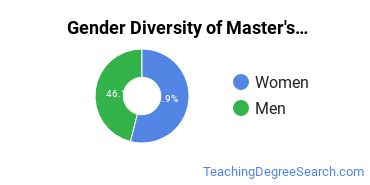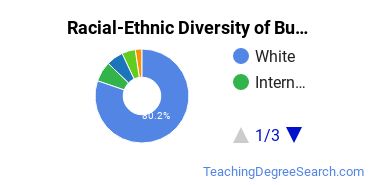Master’s Degrees in Business and Innovation/Entrepreneurship Teacher Education
Education Levels of Business Education Majors
During the most recent year for which data is available, 57 people earned their master's degree in business education. This earns it the #77 spot on the list of the most popular master's degree programs in the nation.
The following table shows the number of diplomas awarded in business education at each degree level.
| Education Level | Number of Grads |
|---|---|
| Bachelor’s Degree | 93 |
| Master’s Degree | 57 |
| Graduate Certificate | 2 |
| Basic Certificate | 1 |
Earnings of Business Education Majors With Master’s Degrees
We are unable to calculate the median earnings for business education majors with their master's degree due to lack of data.
Student Debt
The data on debt ranges for business education majors who have their master's degree is not available.
Student Diversity
More women than men pursue their master's degree in business education. About 57.9% of graduates with this degree are female.
| Gender | Number of Grads |
|---|---|
| Men | 24 |
| Women | 33 |

The racial-ethnic distribution of business education master’s degree students is as follows:
| Race/Ethnicity | Number of Grads |
|---|---|
| Asian | 1 |
| Black or African American | 3 |
| Hispanic or Latino | 5 |
| White | 30 |
| International Students | 5 |
| Other Races/Ethnicities | 13 |

Most Popular Business Education Programs for Master’s Degrees
There are 29 colleges that offer a master’s degree in business education. Learn more about the most popular 20 below:
SUNY Oswego tops the list of the most popular school in the U.S. for business education majors who are seeking their master's degree. Roughly 7,600 attend the school each year. The average in-state tuition for full-time undergraduates is $7,070 per year, while in-state graduate students, on average, pay $11,310 per year. During the most recent year for which we have data, 15 people received their master's degree in business education from SUNY Oswego. Around 14% of these students were from an underrepresented racial-ethnic group, and 57% were women.
Ball State University is the 2nd most popular school in the nation for students seeking a master's degree in business education. Each year, around 21,500 students seeking various degrees attend the university. The average in-state tuition for full-time undergraduates is $8,688 per year, while in-state graduate students, on average, pay $9,922 per year. During the most recent year for which we have data, 14 people received their master's degree in business education from Ball State. About 50% of this group were women, and 25% were students from an underrepresented racial-ethnic group.
University of Wisconsin - Whitewater comes in at #3 on our list of the most popular colleges offering master's degrees in business education. Each year, around 11,900 students seeking various degrees attend the university. The average in-state tuition for full-time undergraduates is $6,812 per year, while in-state graduate students, on average, pay $8,858 per year. During the most recent year for which we have data, 11 people received their master's degree in business education from UW - Whitewater.
Hofstra University is the 4th most popular school in the nation for students seeking a master's degree in business education. Roughly 10,400 attend the school each year. The average in-state tuition for full-time undergraduates is $54,335 per year, while in-state graduate students, on average, pay $29,340 per year. During the most recent year for which we have data, 8 people received their master's degree in business education from Hofstra.
Niagara University is the 4th most popular school in the nation for students seeking a master's degree in business education. Each year, around 3,500 students seeking various degrees attend the university. The average in-state tuition for full-time undergraduates is $36,100 per year, while in-state graduate students, on average, pay $14,850 per year. During the most recent year for which we have data, 8 people received their master's degree in business education from Niagara.
University of the Cumberlands is the 6th most popular school in the nation for students seeking a master's degree in business education. Roughly 19,100 attend the school each year. The average in-state tuition for full-time undergraduates is $9,875 per year, while in-state graduate students, on average, pay $4,260 per year. During the most recent year for which we have data, 6 people received their master's degree in business education from Cumberlands.
Johnson & Wales University - Providence is the 7th most popular school in the nation for students seeking a master's degree in business education. The average in-state tuition for full-time undergraduates is $39,792 per year, while in-state graduate students, on average, pay $15,156 per year. During the most recent year for which we have data, 5 people received their master's degree in business education from JWU Providence.
Hastings College comes in at #8 on our list of the most popular colleges offering master's degrees in business education. The average in-state tuition for full-time undergraduates is $33,950 per year, while in-state graduate students, on average, pay $11,400 per year. During the most recent year for which we have data, 4 people received their master's degree in business education from Hastings.
The 9th most popular school in the country for business education majors who are seeking their master's degree is Clarkson University. The average in-state tuition for full-time undergraduates is $56,642 per year, while in-state graduate students, on average, pay $36,000 per year. During the most recent year for which we have data, 3 people received their master's degree in business education from Clarkson. Of these students, 100% were women and 100% were members of underrepresented racial-ethnic groups.
Buffalo State is the 11th most popular school in the nation for students seeking a master's degree in business education. Each year, around 8,300 students seeking various degrees attend the university. The average in-state tuition for full-time undergraduates is $7,070 per year, while in-state graduate students, on average, pay $11,310 per year. During the most recent year for which we have data, 2 people received their master's degree in business education from Buffalo State. About 80% of this group were women, and 20% were students from an underrepresented racial-ethnic group.
The 11th most popular school in the country for business education majors who are seeking their master's degree is Lee University. Roughly 5,200 attend the school each year. The average in-state tuition for full-time undergraduates is $21,960 per year, while in-state graduate students, on average, pay $16,470 per year. During the most recent year for which we have data, 2 people received their master's degree in business education from Lee University.
The 15th most popular school in the country for business education majors who are seeking their master's degree is California State University - Sacramento. Each year, around 32,200 students seeking various degrees attend the university. The average in-state tuition for full-time undergraduates is $5,742 per year, while in-state graduate students, on average, pay $7,176 per year. During the most recent year for which we have data, 1 people received their master's degree in business education from Sac State. Of these students, 50% were women and 50% were members of underrepresented racial-ethnic groups.
Explore Major by State
Alabama
Arkansas
Connecticut
Florida
Idaho
Iowa
Louisiana
Massachusetts
Mississippi
Nebraska
New Jersey
North Carolina
Oklahoma
Rhode Island
Tennessee
Vermont
West Virginia
Related Majors
Below are some popular majors that are similar to business education that offer master’s degrees.
| Major | Annual Degrees Awarded |
|---|---|
| Reading Education | 4,837 |
| Mathematics Education | 1,666 |
| Physical Education & Coaching | 1,554 |
| Other Teacher Education | 1,261 |
| Music Education | 1,142 |
References
*The racial-ethnic minority student count is calculated by taking the total number of students and subtracting white students, international students, and students whose race/ethnicity was unknown. This number is then divided by the total number of students at the school to obtain the percentage of racial-ethnic minorities.
- College Factual
- National Center for Education Statistics
- O*NET Online
- Bureau of Labor Statistics
- Image Credit: By Aparajita Datta under License
More about our data sources and methodologies.












